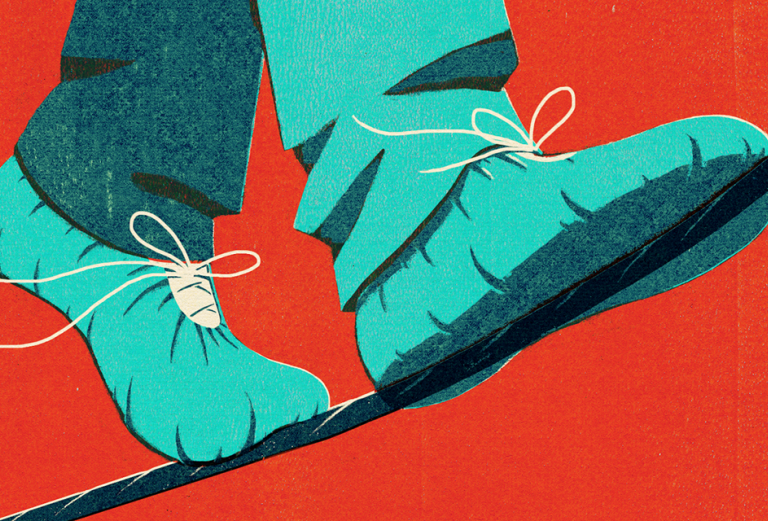Safety Net
The healing profession is taking a clear-eyed look at depression within its ranks
- 14 minute read
- Feature

The reactions of family and friends to the news that he was going into psychiatry left Nathaniel Morris, MD ’16, with the impression that he was somehow wasting his education. But the real surprise, he wrote in the Wall Street Journal in 2016, came as he was interviewing for residency programs and was assured that psychiatry was respected, just like any other department in their hospitals. The need to even mention this gave Morris pause.
Stigma still swirls around mental illness, even within the medical profession. Research has shown that medical professionals do not differ significantly from the general public in their views of patients with mental illness. In fact, some evidence shows that their beliefs and attitudes can be even more negative than those outside of medicine.
Morris, now a resident physician in psychiatry at Stanford University School of Medicine, has more than a professional interest in physician depression. While still in medical school, he started writing essays and blog posts for various publications on topics in medicine. Writing in the Washington Post one week before his graduation, Morris wrote of taking a quiz that would tell him if he met the criteria for depression.
He did.
He sought and received help, with good results, but only after he tearfully admitted to his advisor that he was not okay.

Leonard Su, a former vascular surgeon in Seattle, probably would not have considered taking such a quiz; he was convinced that despite the unrelenting abusive voices in his psyche, he couldn’t be depressed.
“My inner voice was incredibly hateful and kind of spiteful so that no matter what I did, it was always negative,” says Su. “I had this idea that depressed people didn’t do anything, that they sat in a dark room or didn’t get out of bed, so because I was doing so many things, I couldn’t be depressed.” Su ended up leaving medicine after ten years as a surgeon and now speaks publicly about his own mental illness and the importance of destigmatizing such disorders.
Efforts are underway to break through many of the obstacles that impede our understanding of how physicians and physicians in training are affected by mental illness. Increasingly, the profession is looking inward, charting better ways to define and measure such illnesses, evaluating the effect of physicians leaving medicine because of depression and burnout, determining what kinds of supports medical schools and training programs should offer students and trainees, and addressing the persistent stigma of mental illness within the profession and outside of it.
Who, me?
Negative attitudes toward mental illness are particularly concerning to those in a caregiving profession. It has long been almost taboo among physicians to admit to having a problem, and even today, having depression or another form of mental illness can be talked about in hushed tones.
Many medical professionals fear having a record that shows they sought help—a fear that may be well-founded. The medical licensing applications for thirty-two states still contain questions about a history of mental health problems. Such questions may violate the Americans with Disabilities Act. An example from New Hampshire’s application, which, according to a Journal of the American Academy of Psychiatry and the Law article in 2018, is not consistent with ADA regulations, asks, “Have you ever had any physical, emotional, or mental illness which has impaired or would be likely to impair your ability to practice medicine?”

In physicians, the presence of depression is at least as common as it is among the general population, that is, 7 percent of U.S. adults; and, like anyone else, physicians are not good at recognizing the problem in themselves.
On top of that, physicians are notably reluctant to seek help for any illness, never mind depression. Physicians aren’t trained to be “physician’s physicians,” and getting help from colleagues can be a difficult ask.
All this can lead to untreated depression, which raises the short-term risk for suicide and the long-term risk for repeated depressive episodes. Because physicians have access to and knowledge of the means to end their life, they have a suicide completion rate estimated at twice that of the general population, according to a 2018 report published in Medscape.
Students and physicians in training, new to their careers and in a highly competitive environment, are even less likely to admit that they have a problem.
Deep dive
The scope of depression can be difficult to pin down. Definitions are sliced differently and, probably even more relevant, there is a lack of standardized measurement tools.
Douglas Mata, an HMS clinical fellow in pathology at Brigham and Women’s Hospital, became interested in depression and suicide in interns and residents after two of his former classmates died by suicide. Preparing to write a paper with researchers on the Intern Health Study out of the University of Michigan, a longitudinal cohort study looking at stress and mood in medical interns, he found that there was no published review summarizing the knowledge about depression in residents. He determined he would write his own.
“I’m going to find every single study that’s ever been published that measured depression in resident physicians, and I’m going to combine all the data from those studies and create an overall answer,” he recalls thinking.
And he and colleagues did, reporting in JAMA in 2015 that across the fifty-four studies they analyzed, the prevalence of depression or depressive symptoms ranged from 20.9 percent to 43.2 percent, depending on the measurement tool used. In addition, between 1963 through 2015, the years of the studies that were reviewed, prevalence grew modestly. Overall, the researchers reported a summary estimate of 28.8 percent prevalence among residents for screening positive for depression.
In a study published in 2016 in JAMA on depression and suicidal ideation in medical students, Mata and Lisa Rotenstein, MD ’17, a clinical fellow in medicine at Brigham and Women’s, found an overall prevalence of 27 percent for screening positive for depression and of 11 percent for suicidal ideation. Of those who screened positive for depression, the authors note, only 15.7 percent had sought treatment.
Internal combustion
A familiar, and related, phenomenon, burnout, also figures into the depression and suicide equation. Burnout, first noted in the scientific literature in the 1970s, is defined as having three components: emotional exhaustion, depersonalization or detachment, and a sense of personal ineffectiveness. Unlike mental illness, which is often considered a personal failing, burnout is thought of as a work-related syndrome and is thus less stigmatized and pathologized than depression, not only in medicine, but across professions.
Research published in Mayo Clinic Proceedings in February compared the prevalence of burnout and work-life satisfaction in physicians with that in a probability-based sample of the U.S. working population and found that, while physicians’ risk of burnout is higher than in other professions, their prevalence of burnout decreased during the years studied, 2011 to 2017. In contrast, symptoms of depression in physicians increased during the same period.
Another study, published in PLOS One in 2016, showed that the more affected a physician was by symptoms of burnout, the greater their chance of also having depression, a finding that led the researchers to postulate that burnout may be a form of depression.
Rotenstein started studying burnout because of her interest in the business side of medicine and in exploring what she calls the workforce implications of depression and burnout in medicine. “People are more likely to cut back on hours worked. Burnout is associated with worse clinical care. I wanted to be able to understand the phenomenon from a care-delivery perspective as well,” she says.
Another question she is looking at is whether burnout is an individual problem or a systemic one.
“It’s constructive to think about the systemic issues that contribute to burnout and depression,” says Rotenstein. “It gives us a completely different set of levers by which to solve the problem. It also helps us avoid a culture of blame, of individual blame.”
Should we worry if some physicians leave the profession because of its challenges? Consider what is lost when a physician leaves medicine: the experience and skills of a talented health professional, the investment in training and the financial burden of replacing that individual, and the sundering of physician-patient bonds followed by the need to redistribute the patients left adrift. This loss is compounded when physicians of color leave the profession, as research has shown that these physicians are more likely to practice in underserved communities.
Getting picked for the team
Medical education and training programs, especially the most competitive, are objectively stressful and demanding. And, as in any challenging environment, some people thrive while others struggle. There are individual traits that can contribute to risk for depression, such as anxiety, perfectionism, impostor syndrome, cynicism, and being a “high control” person, as well as environmental factors such as long hours, loss of autonomy, less time with patients, ethical issues, and economic worries.
Environmental factors affect everyone in medical training, but how do you know which students will need help?
It’s constructive to think about the systemic issues that contribute to burnout and depression.
In a letter published in Medical Education in 2015, Mata suggested one way to remove some of that guesswork. Before the start of clinical training, he wrote, students could be assessed for their risk of depression using the thirteen-question sense of coherence scale, which assesses how people manage stress.
While they may have some unique stressors, physicians are not the only ones in medically related fields who face occupational stress. Veterinarians and dentists share similar risks of depression and suicide as physicians. And studies of students in graduate programs in several disciplines show a similar prevalence of depression.
One study of 2,279 graduate students from 26 countries and 234 institutions of higher education, published in Nature Biotechnology in 2018, found that 39 percent of the participants scored on a validated depression scale as having symptoms of moderate to severe depression. The authors add that transgender and gender nonconforming students face increased risk for depression over their gender-conforming counterparts, 57 percent, compared with 41 percent (females) and 35 percent (males).
A study in 2015 in the Journal of Racial and Ethnic Health Disparities compared risk for depressive and anxiety symptoms by race and gender in first-year medical students in the United States. Among factors that added to the risk of depression and anxiety in the students was “stereotype threat,” defined as a “disruptive psychological state” in which individuals bear the stress of being seen as confirming negative group stereotypes.
An unexpected finding of this study was that Black women did not end up with a double dose of risk; rather, the researchers found an interaction effect suggesting that Black women were at “slightly less risk for depressive symptomology and anxiety than would be expected given the main effect of race and gender.”
While women and Black students in this study were at higher risk for depression and anxiety than their male and white counterparts, women generally had more social supports and coping skills than men, say the researchers, leading them to note that the “effect of race on social support changes depending on the gender of the medical student.”
Light source
There are reasons to be optimistic about early interventions and prevention. Mental health is beginning to be more openly discussed and taken seriously as a medical condition rather than a moral failing.
And higher education is paying attention. Paul Barreira, an HMS associate professor of psychiatry at McLean Hospital and executive director of Harvard University Health Services, has studied student mental health for many years and has recently looked at how the problem of depression and suicide risk manifests in graduate programs. His reviews have included eight top-tier economics programs in the United States and the Harvard departments of physics and earth and planetary sciences as well as its integrative life sciences programs.

What he found led him to recommend that graduate programs police their own environmental factors that affect students’ mental health—and accept responsibility for addressing those factors.
Student health services can help at the individual level but can’t handle everything, Barreira says, adding that there is also “an important correlation between the nature of the relationship between students’ advising faculty and what their rates are for depression and anxiety.” Here, a solution might be to institute a program in which faculty who have a record of working well with students mentor other faculty on how to improve relationships with their advisees.
Interventions being considered in medical education include resilience-based strategies to promote enthusiasm and learning during residency, a focus on student and resident well-being, and encouragement of faculty, peer, family, and social network supports.
While individual-level strategies are worthwhile, there are studies showing that systems-level interventions, such as altering work hours and call schedules, may be more effective, Rotenstein says. This idea is in line with the 2018 JAMA Charter on Physician Well-Being, which recommends societal commitments, such as fostering a trustworthy and supportive culture in medicine and advocating for policies that enhance well-being; organizational commitments, such as building supportive systems, developing engaged leadership, and optimizing highly functioning interprofessional teams; and interpersonal and individual commitments, including anticipating and responding to inherent emotional challenges of physician work, prioritizing mental health care, and practicing and promoting self-care.
Because of his fears about licensing and residency applications, Morris did not take advantage of the student support structures available when he was an HMS student struggling with depression. He did find the Patient-Doctor 3 course to be a “really profound support network. In it, we all talked about what we were going through as third-year medical students.”
Michael Barton, a first-year medical student at HMS, says that different kinds of support are important because “medical students are more than just our test scores and resumes. We are a complex blend of many different dimensions of well-being—academic, environmental, social, psychological, and physical. Having an institution and community that supports us as whole students is vital.”
Recent School initiatives, says Jennifer Potter, MD ’87, an HMS professor of medicine at Beth Israel Deaconess Medical Center, focus on wellness and mental health programs that include structural changes as well as the development of new curricular and extracurricular opportunities. Barton, as a wellness initiatives appointee to the HMS Student Council, works with Potter and others on new programs or support structures.
“Medical school is a challenging experience on many levels,” says Potter, who also directs the HMS student wellness initiative and is an advisory dean for students in the Castle Society. “We offer formal and informal instruction in wellness and health promotion approaches such as mindfulness and positive psychology. Also crucial are our programs for students seeking help. We’re working to enhance awareness by offering screening for depression; we’ve expanded counseling hours at student health services, and, through a partnership, we’re offering an online counseling service.”
Morris and Su each had his own response to their experience with depression, but both are part of a profession that is dedicated to healing. HMS continues to add individual-level programs and infrastructural changes to make the School more welcoming and supportive for all students.
Susan Karcz is the associate editor of Harvard Medicine magazine.
Images: Daniel Bejar (illustration); John Soares (Rotenstein); Elisabeth Fall (Morris)